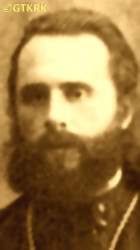Roman Catholic
St Sigismund parish
05-507 Słomczyn
85 Wiślana Str.
Konstancin deanery
Warsaw archdiocese, Poland
full list:
displayClick to display full list

searchClick to search full list by categories
wyświetlKliknij by wyświetlić pełną listę po polsku

szukajKliknij by przeszukać listę wg kategorii po polsku

Martyrology of the clergy — Poland
XX century (1914 – 1989)
personal data
surname
SCIEPURA
surname
versions/aliases
STEPURO
forename(s)
Basil (pl. Bazyli)

function
presbiter (i.e. iereus)
creed
Eastern Orthodox Church ORmore on
en.wikipedia.org
[access: 2014.09.21]
diocese / province
Minsk OR eparchymore on
en.wikipedia.org
[access: 2020.09.24]
nationality
Belarusian
date and place
of death

ITL KarLagGuLAG slave labour camp network
today: n. Karaganda, Karaganda reg., Kazakhstan
more on
en.wikipedia.org
[access: 2019.10.13]
alt. dates and places
of death
1937
details of death
Arrested for the first time by the Russians on 30.12.1928 in the Novye Darohy parish. Accused of „anti–Russian agitation” and sentenced to 3 years of exile. Deported „to the Urals”.
After the end of his sentence, returned to Belarus and moved to Slutsk.
There, on 14.03.1933 (or, according to other sources, 21.04.1933), arrested again. Held prob. in Slutsk. On 09.06.1933 sentenced again — again for „anti–Russian agitation” — to 3 more years of exile. This time deported to the vicinity of Karaganda in Kazakhstan.
Further fate unclear.
According to some sources, lived there until so‐called The Great Purge, i.e. the genocidal extermination of „enemies of the Russian state”, and the so‐called «Polish operation», i.e. the genocidal extermination of all Poles living in the Russian state, and on 20.09.1937, was sentenced in Karaganda by the genocidal Russian kangaroo court known as «NKVD Troika» to 10 years of forced slave labor in the Russian Gulag concentration camps.
Transported to the ITL KarLag concentration camp, where was to die of starvation.
cause of death
extermination
perpetrators
Russians
sites and events
ITL KarLagClick to display the description, GulagClick to display the description, 11.08.1937 Russian genocideClick to display the description, Great Purge 1937Click to display the description, Forced exileClick to display the description
date and place
of birth
30.01.1874

Velikie Lukitoday: Velikie Luki ssov., Baranavichy dist., Brest reg., Belarus
more on
be.wikipedia.org
[access: 2024.01.26]
presbyter (holy orders)
ordination
1901

positions held
c. 1933
resident — Slutsktoday: Slutsk dist., Minsk reg., Belarus
more on
en.wikipedia.org
[access: 2021.04.22]
till 1928
parish priest — Novye Darohytoday: Staryya Darohi ssov., Minsk dist., Minsk reg., Belarus
more on
be.wikipedia.org
[access: 2024.01.26] ⋄ Nativity of the Blessed Virgin Mary OR parish
protoiereus (Eng. first priest) — Russian Orthodox Church — dignity conferment
from 1908
parish priest — Turkitoday: Vorotyn ssov., Babruysk dist., Mogilev reg., Belarus
more on
be.wikipedia.org
[access: 2024.01.26] ⋄ Holy Trinity OR parish
from 1901
parish priest — Tonovotoday: Rubezhevichi ssov., Stowbtsy dist., Minsk reg., Belarus
more on
be.wikipedia.org
[access: 2024.01.26] ⋄ St Cosma and St Damian the Martyrs OR parish — prob. — sources state the name of the village as Tonawa Słoboda (Rus. Тоннова Слобода), the location of which could not be found, but in the vicinity of Tonava there is the village of Tikhonova Sloboda
1901
presbiter (Eng. priest, i.e. iereus) — Russian Orthodox Church — priesthood cheirotonia, i.e. ordination
psalmist — Velikaya Slobodatoday: Turec ssov., Karelichy dist., Grodno reg., Belarus
more on
be.wikipedia.org
[access: 2024.01.26] ⋄ Our Lord's Resurrection OR church
till 1895
student — Minsktoday: Minsk city reg., Belarus
more on
en.wikipedia.org
[access: 2020.07.31] ⋄ philosophy and theology, Orthodox Theological Seminary
married — at least two daughters
sites and events
descriptions
ITL KarLag: Russian Rus. Исправи́тельно‐Трудово́й Ла́герь (Eng. Corrective Labor Camp) ITL Rus. Карагандинский (Eng. Karagandskiy) — concentration and slave forced labor camp (within the Gulag complex) — with headquarters in the city of Karaganda, Karaganda Oblast in Kazakhstan. Founded on 17.09.1931. One of the largest in the Gulag complex. It covered an area of 300 by 200 km, with its center in the Dolynka village, c. 45 km from Karaganda. One of the tasks was to grow food, especially animal husbandry, for the emerging centers of coal mining and heavy industry in Kazakhstan. Prisoners slaved in camp workshops (metal processing, drawing, tailoring), in the production of construction materials, in a glassworks, a sugar refinery, a vegetable drying plant, in coal mines, limestone mining, and in fishing. At its peak, c. 65,000 prisoners were held there: e.g. 45,798 (01.01.1943); 50,080 (01.01.1944); 53,946 (01.01.1945); 60,745 (01.01.1947); 63,555 (01.01.1948); 65,673 (01.01.1949); 54,179 (01.01.1950); 45,675 (01.01.1951). In total, c. 1,000,000 people passed through the camp, including many women and children. Many died. It ceased operations on 27.07.1959. (more on: en.wikipedia.orgClick to attempt to display webpage
[access: 2019.10.13])
Gulag: The acronym Gulag comes from the Rus. Главное управление исправительно‐трудовых лагерей и колоний (Eng. Main Board of Correctional Labor Camps). The network of Russian concentration camps for slave labor was formally established by the decision of the highest Russian authorities on 27.06.1929. Control was taken over by the OGPU, the predecessor of the genocidal NKVD (from 1934) and the MGB (from 1946). Individual gulags (camps) were often established in remote, sparsely populated areas, where industrial or transport facilities important for the Russian state were built. They were modeled on the first „great construction of communism”, the White Sea‐Baltic Canal (1931‐1932), and Naftali Frenkel, of Jewish origin, is considered the creator of the system of using forced slave labor within the Gulag. He went down in history as the author of the principle „We have to squeeze everything out of the prisoner in the first three months — then nothing is there for us”. He was to be the creator, according to Alexander Solzhenitsyn, of the so‐called „Boiler system”, i.e. the dependence of food rations on working out a certain percentage of the norm. The term ZEK — prisoner — i.e. Rus. заключенный‐каналоармец (Eng. canal soldier) — was coined in the ITL BelBaltLag managed by him, and was adopted to mean a prisoner in Russian slave labor camps. Up to 12 mln prisoners were held in Gulag camps at one time, i.e. c. 5% of Russia's population. In his book „The Gulag Archipelago”, Solzhenitsyn estimated that c. 60 mln people were killed in the Gulag until 1956. Formally dissolved on 20.01.1960. (more on: en.wikipedia.orgClick to attempt to display webpage
[access: 2024.04.08])
11.08.1937 Russian genocide: On 11.08.1937 Russian leader Stalin decided and NKVD head, Nicholas Jeżow, signed a «Polish operation» executive order no 00485. 139,835 Poles living in Russia were thus sentenced summarily to death. According to the records of the „Memorial” International Association for Historical, Educational, Charitable and Defense of Human Rights (Rus. Международное историко‐просветительское, правозащитное и благотворительное общество „Мемориал”), specialising with historical research and promoting knowledge about the victims of Russian repressions — 111,091 were murdered. 28,744 were sentenced to deportation to concentration camps in Gulag. Altogether however more than 100,000 Poles were deported, mainly to Kazakhstan, Siberia, Kharkov and Dniepropetrovsk. According to some historians, the number of victims should be multiplied by at least two, because not only the named persons were murdered, but entire Polish families (the mere suspicion of Polish nationality was sufficient). Taking into account the fact that the given number does not include the genocide in eastern Russia (Siberia), the number of victims may be as high as 500,000 Poles. (more on: en.wikipedia.orgClick to attempt to display webpage
[access: 2016.03.14])
Great Purge 1937: „Great Terror” (also «Great Purge», also called „Yezhovshchyna” after the name of the then head of the NKVD) — a Russian state action of political terror, planned and directed against millions of innocent victims — national minorities, wealthier peasants (kulaks), people considered opponents political, army officers, the greatest intensity of which took place from 09.1936 to 08.1938. It reached its peak starting in the summer of 1937, when Art. 58‐14 of the Penal Code about „counter‐revolutionary sabotage” was passed , which became the basis for the „legalization” of murders, and on 02.07.1937 when the highest authorities of Russia, under the leadership of Joseph Stalin, issued a decree on the initiation of action against the kulaks. Next a number of executive orders of the NKVD followed, including No. 00439 of 25.07.1937, starting the liquidation of 25,000‐42,000 Germans living in Russia (mainly the so‐called Volga Germans); No. 00447 of 30.07.1937, beginning the liquidation of „anti‐Russian elements”, and No. 00485[2] of 11.08.1937, ordering the murder of 139,835 people of Polish nationality (the latter was the largest operation of this type — encompassed 12.5% of all those murdered during the «Great Purge», while Poles constituted 0.4% of the population). In the summer of 1937 Polish Catholic priests held in Solovetsky Islands, Anzer Island and ITL BelbaltLag were locked in prison cells (some in Sankt Petersburg). Next in a few kangaroo, murderous Russian trials (on 09.10.1937, 25.11.1937, among others) run by so‐called «NKVD Troika» all were sentenced to death. They were subsequently executed by a single shot to the back of the head. The murders took place either in Sankt Petersburg prison or directly in places of mass murder, e.g. Sandarmokh or Levashov Wilderness, where their bodies were dumped into the ditches. Other priests were arrested in the places they still ministered in and next murdered in local NKVD headquarters (e.g. in Minsk in Belarus), after equally genocidal trials run by aforementioned «NKVD Troika» kangaroo courts.
Forced exile: One of the standard Russian forms of repression. The prisoners were usually taken to a small village in the middle of nowhere — somewhere in Siberia, in far north or far east — dropped out of the train carriage or a cart, left out without means of subsistence or place to live. (more on: en.wikipedia.orgClick to attempt to display webpage
[access: 2014.12.20])
sources
personal:
martyrs.pstbi.ruClick to attempt to display webpage
[access: 2024.01.26], wiki.bobr.byClick to attempt to display webpage
[access: 2024.01.26]
bibliographical:
„Hierachy, clergy and employees of the Orthodox Church in the 19th‐21st centuries within the borders of the Second Polish Republic and post–war Poland”, Fr Gregory Sosna, M. Antonine Troc-Sosna, Warsaw–Bielsk Podlaski 2017
original images:
martyrs.pstbi.ruClick to attempt to display webpage
[access: 2024.01.26], wiki.bobr.byClick to attempt to display webpage
[access: 2024.01.26]
LETTER to CUSTODIAN/ADMINISTRATOR
If you have an Email client on your communicator/computer — such as Mozilla Thunderbird, Windows Mail or Microsoft Outlook, described at WikipediaPatrz:
en.wikipedia.org, among others — try the link below, please:
LETTER to CUSTODIAN/ADMINISTRATORClick and try to call your own Email client
If however you do not run such a client or the above link is not active please send an email to the Custodian/Administrator using your account — in your customary email/correspondence engine — at the following address:

giving the following as the subject:
MARTYROLOGY: SCIEPURA Basil
To return to the biography press below:
 Click to return to biography
Click to return to biography









